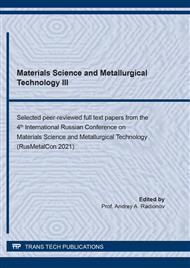[1]
H. Lee, et al., Mechanical matching and microstructural evolution at the coating/substrate interfaces of cold-sprayed Ni, Al coatings, Journal of Alloys and Compounds. 478(1-2) (2009) 636-641.
DOI: 10.1016/j.jallcom.2008.11.150
Google Scholar
[2]
M.H. Enayati, et al., Nanocrystalline NiAl coating prepared by HVOF thermal spraying, Journal of Thermal Spray Technology. 20(3) (2011) 440-446.
DOI: 10.1007/s11666-010-9588-7
Google Scholar
[3]
Ch. Wang, et al., Effect of rare-earth on friction and wear properties of laser cladding Ni-based coatings on 6063Al, Journal of Alloys and Compounds. 727 (2017) 278-285.
DOI: 10.1016/j.jallcom.2017.08.101
Google Scholar
[4]
I. Sah, S.H. Kim, Ch. Jang, Microstructure and creep resistance of a diffusionally aluminized Ni-base superalloy, Metals and Materials International. 22(6) (2016) 1033-1040.
DOI: 10.1007/s12540-016-6218-z
Google Scholar
[5]
V.G. Shmorgun, et al., The kinetics of diffusion processes in the nickel-aluminum composition, Russian Journal of Non-Ferrous Metals. 50 (3) (2009) 286-289.
DOI: 10.3103/s1067821209030195
Google Scholar
[6]
J.M. Brossard, et al., High-temperature oxidation of an aluminized NiCr alloy formed by a magnetron-sputtered Al diffusion coating, Oxidation of Metals. 64(1-2) (2005) 43.
DOI: 10.1007/s11085-005-5705-2
Google Scholar
[7]
D.F. Susan, A.R. Marder, Ni-Al composite coatings: diffusion analysis and coating lifetime estimation, Acta Materialia. 49 (2001) 1153-1163.
DOI: 10.1016/s1359-6454(01)00022-2
Google Scholar
[8]
Z.D. Xiang, et al., Degradation kinetics at 650 C and lifetime prediction of Ni2Al3/Ni hybrid coating for protection against high temperature oxidation of creep resistant ferritic steels, Corrosion Science. 53(10) (2011) 3426-3434.
DOI: 10.1016/j.corsci.2011.06.022
Google Scholar
[9]
V.G. Shmorgun, A.I. Bogdanov, A.O. Taube, R.E. Novikov, Investigation of heat resistance of Al-Ni layered coating, Solid State Phenomena. 265 (2017) 211-214.
DOI: 10.4028/www.scientific.net/ssp.265.211
Google Scholar
[10]
V. G. Shmorgun, A.I. Bogdanov, V.P. Kulevich, The oxidation behaviour of layered Al-Ni coating at high-temperature heating, Materials Today: Proceedings. 38 (2021) 1627-1630.
DOI: 10.1016/j.matpr.2020.08.170
Google Scholar
[11]
V.G. Shmorgun, A.I. Bogdanov, A.O. Taube, Effect of the high-heating on the chemical and phase composition of the Al-Ni-Cr layered coatings, Materials Science Forum. 870 (2016) 169-174.
DOI: 10.4028/www.scientific.net/msf.870.169
Google Scholar
[12]
H. Yu, et al., Bonding and sliding wear behaviors of the plasma sprayed NiCrBSi coatings, Tribology International. 66 (2013) 105-113.
DOI: 10.1016/j.triboint.2013.04.017
Google Scholar
[13]
A. Vencl et al., Evaluation of adhesion/cohesion bond strength of the thick plasma spray coatings by scratch testing on coatings cross-sections, Tribology International. 44(11) (2011) 1281-1288.
DOI: 10.1016/j.triboint.2011.04.002
Google Scholar
[14]
International Organization for Standardization. Thermal Spraying - Evaluation of Adhesion/Cohesion of Thermal Sprayed Ceramic Coatings by Transverse Scratch Testing (ISO 27307:2015), (2015).
DOI: 10.3403/30197536
Google Scholar
[15]
M. Perton, et al., Effect of pulsed laser ablation and continuous laser heating on the adhesion and cohesion of cold sprayed Ti-6Al-4V coatings, Journal of Thermal Spray Technology. 21(6) (2012) 1322-1333.
DOI: 10.1007/s11666-012-9812-8
Google Scholar
[16]
E. Byon, et al., Adhesion/Cohesion Strength of Plasma Sprayed Ceramic Coatings by Scratch Testing on Cross-Section, International Thermal Spray Conference and Exposition: Innovative Coating Solutions for the Global Economy, ITSC 2013. ASM International, (2013).
Google Scholar
[17]
S.J. Bull, and E.G. Berasetegui, An overview of the potential of quantitative coating adhesion measurement by scratch testing, Tribology International. 39(2) (2006) 99-114.
DOI: 10.1016/j.triboint.2005.04.013
Google Scholar
[18]
O. V. Kudryakov, V.N. Varavka, and V.V. Ilyasov, Characterization of anti-erosive properties of nanocomposite coatings by the methods of sclerometry, Journal of Physics: Conference Series. 857(1) (2017) 012025.
DOI: 10.1088/1742-6596/857/1/012025
Google Scholar
[19]
J. Pujante et al., High temperature scratch testing of hard PVD coatings deposited on surface treated tool steel, Surface and Coatings Technology. 254 (2014) 352-357.
DOI: 10.1016/j.surfcoat.2014.06.040
Google Scholar
[20]
Ph.V. Kiryukhantsev-Korneev, and A.N. Sheveiko, Specificity of measurements of the hardness of thin functional coatings using sclerometry, Micro-and Nanoindentation Methods, Protection of Metals and Physical Chemistry of Surfaces. 54(5) (2018) 963-968.
DOI: 10.1134/s207020511805012x
Google Scholar
[21]
L. Fu, et al., A new tribological experimental setup to study confined and sheared monolayers, Review of Scientific Instruments. 87(3) (2016) 033903.
DOI: 10.1063/1.4943670
Google Scholar
[22]
A.-T. Akono, Scratch Tests: A New Way of Evaluating the Fracture Toughness of Materials. Diss. Massachusetts Institute of Technology, (2011).
Google Scholar
[23]
A.-T. Akono, and F.-J. Ulm, Scratch test model for the determination of fracture toughness, Engineering Fracture Mechanics. 78(2) (2011) 334-342.
DOI: 10.1016/j.engfracmech.2010.09.017
Google Scholar
[24]
V. Le Houérou, L. Jacomine, and C. Gauthier, Film/substrate adhesion assessment by scratch tests performed with different indenters, Engineering Systems Design and Analysis. 45851 (2014) V003T14A003.
DOI: 10.1115/esda2014-20121
Google Scholar
[25]
J.L. Bucaille, E. Felder, and G. Hochstetter, Mechanical analysis of the scratch test on elastic and perfectly plastic materials with the three-dimensional finite element modeling, Wear. 249(5-6) (2001) 422-432.
DOI: 10.1016/s0043-1648(01)00538-5
Google Scholar
[26]
J.-S. Lin, and Y. Zhou, Can scratch tests give fracture toughness? Engineering Fracture Mechanics. 109 (2013) 161-168.
DOI: 10.1016/j.engfracmech.2013.06.002
Google Scholar
[27]
F. Wredenberg, and P.-L. Larsson, Scratch testing of metals and polymers: Experiments and numerics, Wear. 266(1-2) (2009) 76-83.
DOI: 10.1016/j.wear.2008.05.014
Google Scholar
[28]
R Mises., Mechanic der Plastischen Formandenderung von Kristallen, ZAMM. 8(3) (1928) 161-184.
Google Scholar


